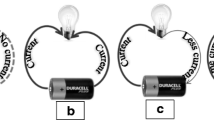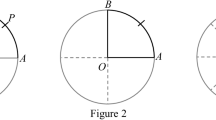Abstract
The research investigated the effect of a science diagram on primary students’ conceptual understanding about magnets. Lack of research involving students of primary age means that little is known about the potential of science diagrams to help them understand abstract concepts such as magnetism. Task-based interviews were conducted individually with 19 year 3 and year 5 students from a single school. Data captured students’ prior ideas about magnets and changes in their understanding in response to a diagram as the only intervention. Results revealed a variety of outcomes—conceptual understanding was enhanced, reduced, simultaneously enhanced and reduced or not changed. Particular diagram features constrained students’ learning for some students. The study confirms the individual nature of primary students’ learning and has implications for teachers about instructional methods using science diagrams.



Similar content being viewed by others
References
Ainsworth, S., & Th Loizou, A. (2003). The effects of self-explaining when learning with text or diagrams. Cognitive Science, 27, 669–681.
Anderson, C. W. (2007). Perspectives on science learning. In S.K. Abell & N. G. Lederman (Eds.), Handbook of research on science education (pp. 3–30). New Jersey: Lawrence Erlbaum Associates.
Bailey, J., Frances, R., & Hill, D. (1987). Exploring ideas about magnets. Research in Science Education, 17(1), 113–116.
Barlex, D., & Carré, C. (1985). Visual communication in science. Cambridge: Cambridge University Press.
Bowen, G. M., & Roth, W. (2002). Why students may not learn to interpret scientific inscriptions. Research in Science Education, 32, 303–327.
Brown, D. E. (1992). A framework for interpreting students’ conceptions. Paper presented at the Annual meeting of the American Educational Research Association, April, San Fransisco, California.
Brown, D. E. (1993). Refocusing core intuitions: A concretizing role for analogy in conceptual change. Journal of Research in Science Teaching, 30(10), 1273–1290.
Brown, D. E. (1995). Theories in pieces? The nature of students’ conceptions and current issues in science education. Paper presented at the Annual Meeting of the National Association for Research in Science Teaching, April 22–25, San Fransisco, California.
Brown, D. E. (2010). Students’ conceptions - coherent or fragmented? And what difference does it make?. Paper presented at the Annual Meeting of the National Association of Research in Science Teaching, March, Philadelphia, PA.
Brown, D. E., & Clement, J. (1989). Overcoming misconceptions via analogical reasoning: Abstract transfer versus explanatory model construction. Instructional Science, 18, 237–261.
Cheng, M., & Brown, D. E. (2010). Conceptual resources in self-developed explanatory models: the importance of integrating conscious and intuitive knowledge. International Journal of Science Education, 32(17), 2367–2392.
Cheng, P. C. H., Lowe, R. K., & Scaife, M. (2001). Cognitive science approaches to understanding diagrammatic representations. Artificial Intelligence Review, 15(1–2), 79–94.
Chittleborough, G., & Treagust, D. (2008). Correct interpretation of chemical diagram requires transforming from one level of representation to another. Research in Science Education, 38, 463–482.
Clement, J. J. (2000). Analysis of clinical interviews: Foundations and model viability. In A. E. Kelly & R. A. Lesh (Eds.), Handbook of research design in mathematics and science education (pp. 547–589). New Jersey: Lawrence Erlbaum Associates, Inc.
Clement, J. J. (2008). The role of explanatory models in teaching for conceptual change. In S. Vosniadou (Ed.), International handbook of research on conceptual change (pp. 417–452). New York: Routledge.
Cohen, L., Manion, L., & Morrison, K. (2011). Research methods in education (7th ed.). New York: Routledge.
Coleman, J., McTigue, E., & Smolkin, L. (2011). Elementary teachers’ use of praphical representations in science teaching. Journal of Science Teacher Education, 22(613–643).
Constable, H., Campbell, B., & Brown, R. (1988). Sectional drawings from science textbooks: An experimental investigation into pupil’s understanding. British Journal of Educational Psychology, 58, 89–102.
diSessa, A. (2002). Why “conceptual ecology” is a good idea. In M. Limón & L. Mason (Eds.), Reconsidering conceptual change. Issues in theory and practice (pp. 29–60). The Netherlands: Kluwer Academic Publishers.
diSessa, A. (2004). Meta-representation: naïve competence and targets for instruction. Cognition and Instruction, 22(3), 293–331.
Driver, R. (1989). Students’ conceptions and the learning of science. International Journal of Science Education, 11(Special Issue), 481–490.
Erickson, G. (1994). Pupils’ understanding of magnetism in a practical assessment context: The relationship between content, process and progression. In P. Fensham, R. Gunstone, & R. White (Eds.), The content of science: a constructivist approach to its teaching and learning (pp. 80–97). London: Falmer Press.
Goldin, G. A. (2000). A scientific perspective on structured, task-based interviews in mathematics education research. In A. E. Kelly & R. A. Lesh (Eds.), Handbook of research and design in mathematics and science education (pp. 517–545). New Jersey: Lawrence Erlbaum Associates, Inc.
Haupt, G. W. (1952). Concepts of magnetism held by elementary school children. Science Education, 36(3), 162–168.
Henderson, G. (1999). Learning with diagrams. Australian Science Teachers Journal, 45(2), 17–25.
Hill, D. M. (1988). Difficulties with diagrams. Journal of Science and Mathematics Education in S.E. Asia, 11(2), 32–40.
Hubber, P., Tytler, R., & Haslam, F. (2008). Year 7 students’ understanding of force as a representational issue: insights from a classroom video study. Paper presented at the conference of the Australasian Science Education Research Association (ASERA), Brisbane, July 2008.
Johnson, B., & Christensen, L. (2004). Educational research: quantitative, qualitative, and mixed approaches. Boston: Pearson Education, Inc.
Levie, H. W., & Lentz, R. (1982). Effects of text illustrations: a review of research. Journal of Educational Communication and Technology, 30, 195–232.
Lowe, R. K. (1986). The scientific diagram: is it worth a thousand words? The Australian Science Teachers Journal, 32(2), 7–13.
Lowe, R. K. (1987). Mental representation and diagram interpretation. Australian Educational Research, 15(1), 37–50.
Lowe, R. K. (1988). “Reading” scientific diagrams: characterising components of skilled performance. Research in Science Education, 18, 112–122.
Lowe, R. K. (1989). Search strategies and inference in the exploration of scientific diagrams. Educational Phsychology, 9(1), 27–44.
Lowe, R. K. (1993a). Scientific diagrams: How well can students read them? In B. Fraser (Ed.), Research implications for science and mathematics teachers (Vol. 1, pp. 14–19). Perth: National Key Centre for School Science and Mathematics.
Lowe, R. K. (1993b). Successful instructional diagrams. London: Kogan Page Limited.
Lowe, R. K. (2000). Visual literacy and learning in science. ERIC clearinghouse for science, mathematics and environmental education (pp. 1–2). ERIC Digest, ED463945 Columbus, Ohio: ERIC/CSMEE.
Lum, S. (2008). Evaluation of the science content of connected outcomes groups units adopted by many NSW Department of Education and Training Schools. Unpublished Honours thesis. University of Sydney.
Maxwell, J. (2005). Qualitative research design: an interactive approach. London: Sage.
Prain, V., & Waldrip, B. (2010). Representing science literacies: an introduction. Research in Science Education, 40, 1–3.
Preston, C. (2012). Science diagrams: their effects of Primary students’ conceptual understanding. Unpublished PhD Thesis. University of Sydney.
Ramadas, J. (2009). Visual and spatial modes in science learning. International Journal of Science Education, 31(3), 301–318.
Salomon, G. (1979). Interaction of media, cognition and learning. San Francisco: Jossy-Bass.
Skamp, K. (Ed.). (2012). Teaching primary science constructively (4th ed.). South Melbourne: Cengage.
Tytler, R. (1998). The nature of students’ informal science conceptions. International Journal of Science Education, 20(8), 901–927.
Tytler, R., & Prain, V. (2010). A framework for re-thinking leaning in science from recent cognitive science persepectives. International Journal of Science Education, 32(15), 2055–2078.
Tytler, R., Haslam, F., Prain, V., & Hubber, P. (2009). An explicit representational focus for teaching and learning about animals. Teaching Science, 55(4), 21–27.
Tytler, R., Prain, V., Hubber, P., & Waldrip, B. (2013). Constructing representations to learn in science. Rotterdam: Sense Publishers.
Vekiri, I. (2002). What is the value of graphical displays in learning? Educational Psychology Review, 14(3), 261–312.
Wheeler, A., & Hill, D. (1990). Diagram-ease: Why children misinterpet diagrams. The Science Teacher, 57, 58–63.
Wilcox, J., & Richey, L. R. (2012). May the magnetic force be with you: Using concrete activities to confront misconceptions about magnetism in the primary grades. Science and Children, 50(2), 62–67.
Winn, W. D. (1989). The design and use of instructional graphics. Advances in psychology: Knowledge acquisition from text and pictures, 58, 125–144.
Winn, W. D. (1991). Learning from maps and diagrams. Educational Phsychology Review, 3(3), 211–247 [Review].
Yeh, Y., & McTigue, E. (2009). The frequency, variation and function of graphical representations within standardised state tests. School Science and Mathematics, 109(8), 435–449.
Acknowledgments
The author would like to thank David E. Brown (Illinois) for his helpful comments on a draft version of this paper. The assistance of Janette Bobbis as Early Career mentor is also gratefully acknowledged.
Compliance with Ethical Standards
The study was approved by the Human Research Ethics Committee, University of Sydney and the NSW Department of Education and Training. Informed consent was obtained from the school principal and parents prior to participant involvement.
Author information
Authors and Affiliations
Corresponding author
Appendix A
Appendix A
Magnets Diagram Interview Protocol—Interview 1
Preconceptions
Stimulus—A pair of bar magnets and a horse shoe magnet.

Questions to ask students
Have a look at these what do you think they are?
What do you know about magnets?
What would happen if we had 2 of these magnets [points to the bar magnets] and brought them near each other?
What if the red and the red were together?
What if we had 2 of these magnets [points to the horse shoe magnet] and we brought them near each other?
Does it matter which way we put them together?
Intervention
Stimulus—Diagram (devoid of text)

Can you tell me what’s happening in these pictures please?
Why will that happen?
What about these one, what’s happening over here [direct to part(s) of the diagram not mentioned?
What does the arrow mean in this one [point to top arrow]?
What does the arrow mean here? [point to bottom arrow]
Do you know any words that mean [e.g., going away, coming together, sticking, won’t go together that students use] to do with magnets?
Continued Intervention
Stimulus—Diagram (with text)

If I show you this diagram with the key does that help you?
Which one is attracting force?
Which one is repelling force?
What does attracting force mean?
What is a repelling force?
What’s happening over here [point to diagram part(s) not talked about]
Why does that happen?
What happens to the magnets when the arrows look like that? Why?
Did the key help you with the diagram? How?
Have you learnt about magnets at school?
Interview 2
The interview protocol was repeated after one month delay with equivalent questions as the pre-test: Preconceptions = Post-conceptions; Intervention = Re- intervention; Continued intervention = Continued re-intervention.
Rights and permissions
About this article
Cite this article
Preston, C. Effect of a Science Diagram on Primary Students’ Understanding About Magnets. Res Sci Educ 46, 857–877 (2016). https://doi.org/10.1007/s11165-015-9484-8
Published:
Issue Date:
DOI: https://doi.org/10.1007/s11165-015-9484-8




